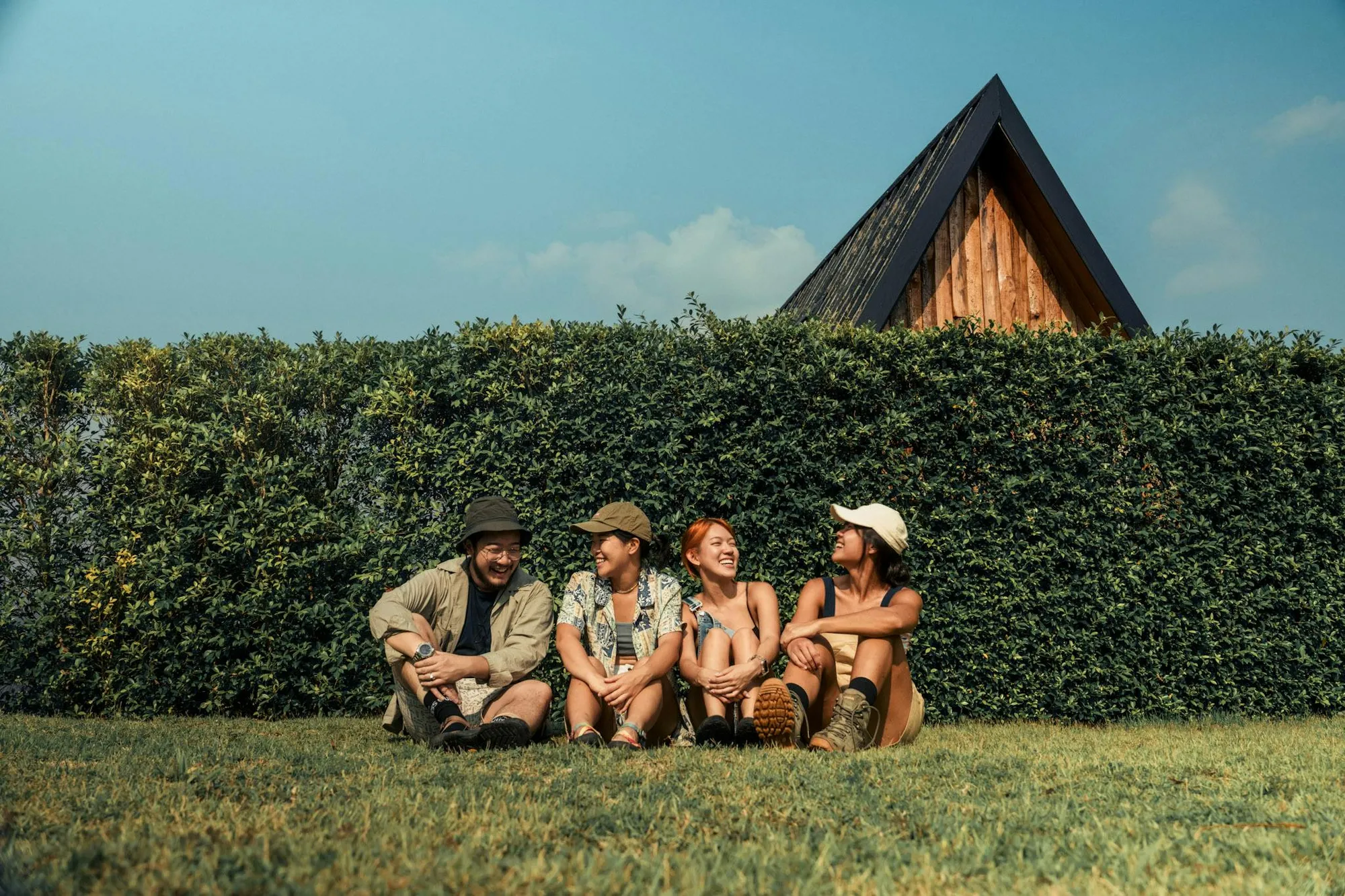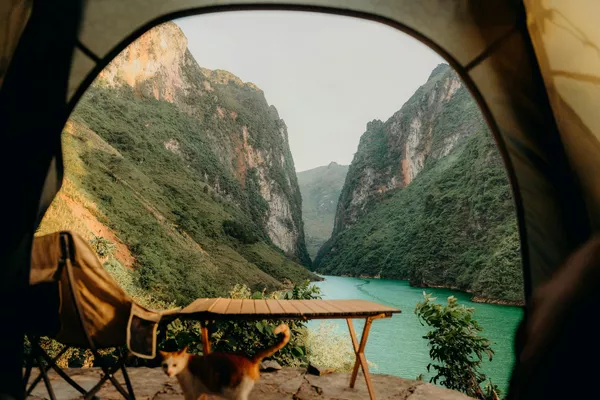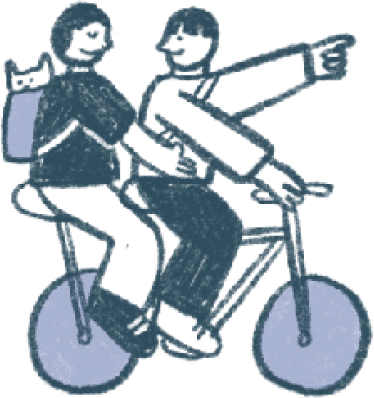Ha Giang Loop: Ultimate Guide + Less Touristy Routes
Everything you need to know to do this epic trip, and how to do it in a less touristy way (hidden campsite + kayaking!)

The Ha Giang Loop is an epic motorbike road trip spanning 350km through Northern Vietnam, and in our opinion, it's one of best experiences you can do in the entire country!
Here's everything you need to know about the Ha Giang Loop, and how to do it in a less-touristy way.
The Basics
Why do the Ha Giang Loop?
It’s one of the very best motorcycle routes and roads in the whole of Southeast Asia – think jaw-dropping mountain views, winding roads, and villages that feel like you’ve stepped back in time.
It’s also the perfect mix of adventure and culture, and it’ll definitely be the highlight of your Vietnam trip (it was ours!).
How many days should I do?
You’ll need at least three days to see the highlights, but if you have the time, four days is so much better. A four-day trip allows you to take your time, enjoy the stops, and soak in everything without feeling like you’re always on the go.
When is the best time to go?
Timing your trip is crucial because the weather can make or break the experience.
Autumn (Sept–Nov): The absolute best time to visit. Sunny with little rain and cool at night. If you’re there from Sept to mid-Oct, you’ll see the rice fields turn a stunning golden colour just before harvest season!
Winter (Dec–Feb): It’s pretty cold, especially at night, with temperatures dropping below 10°C. January and February tend to be foggy, so the views might be hit or miss. Avoid Tet (Vietnamese Lunar New Year) when many businesses close.
Spring (Mar–May): Nice weather, especially from April onward when it gets warmer but still pleasant.
Summer (Jun–Aug): Hot, humid, and rainy with frequent thunderstorms. Probably not the best time for a motorbike trip.
As long as you avoid the rainy season during the summer months and the foggy winter months, any other time of year is a great time to travel the Ha Giang loop!
How do I get to Ha Giang from Hanoi?
There are many bus companies that you can book to get from Hanoi to Ha Giang City, but the easiest way is to make sure that your Ha Giang Loop experience either includes the bus transfer or has it as an add on.
It’s about a 6-hour bus ride, and you can either:
1. Take an overnight sleeper bus (arriving in Ha Giang around 3am with enough time for a couple hours nap and shower before starting the Loop), or
2. Hop on an early morning bus (arriving around lunchtime).
We prefer the overnight bus option because it gives us three full days on the Loop.
Easy rider VS self-riding
There are two ways to do the Ha Giang Loop – easy rider (a local guide who drives while you ride pillion) or self-riding. We highly recommend choosing the easy rider option, and here's why:
1. The roads are challenging
The roads can be tricky—winding paths, steep climbs, and rocky patches. While self-riding is possible (and you’ll need an international driver’s license to do it), navigating these roads can be stressful and even dangerous.
2. Local guides make the trip so much better
Easy Riders are essentially your tour guides! They’re local experts who know the roads, hidden spots, and all the best viewpoints, including places you’d never find on Google Maps. Your guide will also share stories about Hmong tradition and take care of logistics like where to eat and stay, so you can just focus on enjoying the journey.
Types of Ha Giang Loop Experiences
Big Group Tours (40–50 riders):
Most popular Ha Giang tours you see on social media are great for a budget-friendly option, at around $200 for three days. But it's heavy on the party vibe, with plenty of “happy water” (rice wine) basically every night, which we’re not big fans of. The homestays also tend to be more basic.
Smaller Group Tours (10–15 riders):
More chill and intimate experience with nicer homestays, often including unique touches, like exploring less touristy routes or staying at a stunning campsite. It costs a little more (~$300–350 for three days), but the experience is much richer and more meaningful—exactly what we’re looking for in a trip like this!
3-Day Ha Giang Loop Itinerary
Our fave itinerary
Instead of doing the normal Ha Giang Loop itinerary, we chose one that is a little more off-beaten and brought us to a hidden campsite and kayaking — which turned out to be the highlight of our trip!
Day 1: Ha Giang City — Dong Van Town — Quan Ba — Twin Mountains — Hidden Campsite
Day 2: Nho Que River — Ma Pi Leng Pass — Trekking — Hmong King’s Palace
Day 3: Dong Van Town — Tham Ma Pass — Hidden Waterfalls — Ha Giang City
Highlights of the Ha Giang Loop
Quan Ba (Heaven’s Gate)
This stunning viewpoint is one of the first epic viewpoints along the first day on the Loop—the gateway to Dong Van Karst Plateau Geopark. At nearly 1,500 meters above sea level, it offers panoramic views of lush valleys, terraced fields, and towering mountain passes.
Twin Mountains Viewpoint
These two rounded limestone hills also known as Fairy Breast Mountains, surrounded by vibrant rice fields and villages, are as unique as they are photogenic. If you come just before the rice harvest season in mid-October, these rice fields will be a beautiful golden yellow.
Tham Ma Pass
The iconic s-shape zigzagging road that you probably recognise from every Ha Giang Loop travel guide. It’s one of the most popular stops and it’s definitely impressive. Sitting there and watching the bikes and cars drive down is so satisfying, and it makes for a really great photo!
Ma Pi Leng Pass
Often called the “King of Passes,” Ma Pi Leng is the most iconic and beautiful stretch of the loop. With towering cliffs and the turquoise Nho Que River in the valley below, the views here are just jaw-dropping.
Hidden Campsite at Nho Que River
Nho Que River winds through Tu San Canyon, the deepest canyon in Southeast Asia. It’s a popular stop for travellers, and while most tours only do boat rides, we went for something a little different: an overnight stay at a hidden campsite.
The campsite was amazing—clean, cozy tents, hot showers, and a BBQ feast under the stars. And there was only one other local Vietnamese group staying at the campsite! We woke up to a breathtaking view of the canyon as the sun lit up the valley.
Bonus tip: bring an AeroPress (like we did!) or something similar to make coffee—it’s the perfect way to start a morning this gorgeous.
Kayaking
Another reason why we loved this campsite is because we could kayak down the river! This was such a highlight for us. Unlike the noisy tourist boats blasting party music, we got to enjoy the peace and quiet of nature. We paddled at our own pace, swam, skipped stones, and just soaked in the beauty around us. If you’re doing the four-day loop, there will be a floating basket with fruits and beer to enjoy while you paddle!
Heads up: Getting in and out of the campsite was a challenge. We needed to hike 45 minutes out with our backpack, so you’ll need a bit of fitness. But trust us, it’s 100% worth it!
Hiking
Not all Ha Giang Loop tours include hiking, so if this is something you want to do, make sure you check the itinerary before hand. It’s a cool way to experience even more of the natural beauty! We skipped it after our campsite trek (we were happily exhausted!), but there are some great viewpoints that are only accessible via foot. The nice thing is that everything’s customisable—if hiking isn’t your thing, you can totally skip it.
Waterfalls
There are a couple of waterfalls along the Ha Giang Loop and depending on your itinerary, you might not visit any or you might visit a few! The three day itinerary we did included a small roadside waterfall that was nice but nothing special, and another hidden gem waterfall where we got to swim and explore a secret cave.
Hmong King’s Palace
Built in 1902, it was home to the wealthy Hmong ruler and what makes the architecture so special is that it blends Chinese, French, and local Hmong design. Walking through the palace is a cool way to learn about the region’s history and the Hmong people’s culture.
Dong Van Old Town
Dong Van has this old-school charm that’s hard to beat. The cobblestone streets, ancient stone houses, and lively markets make it feel like you’ve gone back in time.
On our last night, we stumbled into a dance party in the town square—locals were rocking out to Vietnamese EDM, and travellers were welcome to join in (we did too!). The night ended with a huge campfire, and it was such a fun way to wrap up the adventure.
Homestays
Staying at local homestays is one of the best parts of the Ha Giang Loop. The hosts are super welcoming and the vibes are just so homey. Our favourite was in Dong Van on the last night—we had a hearty hot pot meal together with our guides, and there’s nothing quite like a cozy bed after a long day on the road.
FAQ
Is the Ha Giang Loop safe?
Yes, it’s safe! As with any motorbike trip, you just need to stay mindful. Always wear your helmet and be extra cautious—especially if you’re snapping selfies near cliffs or steep drops.
How are the road conditions?
The roads on the Loop are a mix of twists, turns, and some bumpy stretches with parts still under construction. That’s why we recommend doing an easy rider—your guide can handle the driving so you can focus on enjoying the views.
Who is it suitable for?
The Ha Giang Loop is a great experience for solo travellers, couples, or even groups! But it’s not great if you have mobility issues or are under 14.
What about my luggage?
Leave your big bags at your Hanoi hotel and bring a backpack with the essentials for your 3-4 day trip. Since the Loop takes you to a new place each night, a smaller bag that fits on the back of a motorbike is key.
Your backpack will be strapped to the bike during the ride, so it’s a good idea to bring a smaller sling bag or day pack for items you’ll need during the day—think phone, camera, sunscreen, water bottle, jacket, and hat.
How should I pack?
Packing light and practical will make your journey much easier. Here’s what we recommend:
Clothing: Comfy, stretchy outfits; a windproof and waterproof jacket; a down jacket for winter or chilly mornings; sandals for kayaking or waterfalls; a bandana or scarf to cover your face; and sturdy shoes for hiking.
Hat, sunscreen, bug spray, basic toiletries, and any meds you might need.
Cash: There’s limited access to ATMs, so bring enough VND before arriving in Ha Giang City.
Small day pack/sling bag: Pack the essentials you’ll need during the day so you can easily access them.
How long am I on the motorbike for each day?
You’ll be on the road for no more than 3 hours a day, broken into short stretches, so it’s very manageable. Typically, you’ll stop every 20 minutes or so at viewpoints, coffee shops, or roadside stops.
Are there toilets along the Loop? Are they clean?
Yes, there are bathrooms at most coffee shops, eateries, and viewpoints along the Loop. They’re basic but functional and usually clean enough.
How cold does it get?
The Ha Giang Loop can get chilly. Mornings and nights are the coldest, with temperatures around 10-15°C in late October and dropping below 10°C in winter. Bring layers like a down jacket to stay cozy!
What is the food like?
You’ll mostly eat at family-style eateries, that are a mix of Vietnamese and Chinese food. Think soups, rice, stir-fried veggies, meat, and BBQ. It’s simple but homemade, and super satisfying after a day of riding.
Do I need to buy insurance?
Yes, travel insurance is highly recommended. If you don’t already have coverage, your tour guide can usually arrange it for you before the trip.
Is there phone signal?
Surprisingly, yes! Viettel's e-sim worked great, and we had reliable service throughout the Loop.
Do the guides speak English?
Most easy rider guides on the Ha Giang Loop can speak at least basic English. Some of your guides might be Hmong, and because they live so close to China’s border, your Hmong guide might be able to understand a little bit of Mandarin as well.
Motorcycle Tour in Ha Giang FAQs
What makes Ha Giang a popular destination for motorcycle tours?
What is the best time of year for a motorcycle tour in Ha Giang?
What stops will be included in the typical Ha Giang motorcycle tour?
What are the requirements for taking a motorcycle tour in Ha Giang?
Can solo riders join a motorcycle tour in Ha Giang?



































![18 Cool Things to Do in Hanoi (Beyond the Old Quarter) [2025]](https://d18sx48tl6nre5.cloudfront.net/webp_md_fad8a384e32eddaa2d7e5f92d2ab163b.webp)

![Sapa: Your Essential Guide + How to Ditch the Crowds [2025]](https://d18sx48tl6nre5.cloudfront.net/webp_md_e2c27b494af0107f86f45ff86df82820.webp)







